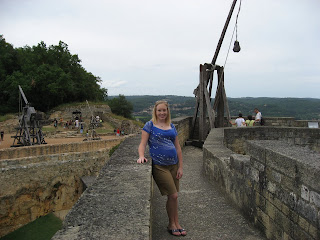


During our recent trip in the Dordogne, we visited one of the many foie gras farms in the area. This region is renowned for its foie gras, largely made from goose liver here (most duck foie gras is produced closer to home).
Foie gras translates to fatty liver. It is made by feeding the goose or duck large quantities of corn over a period of several weeks to fatten its liver. The liver is then prepared in several ways for eating. It is a delicacy, and in France an expensive treat enjoyed especially at Christmas-time. The production of foie gras has a bad rap from animal rights activists, that believe the feeding process is cruel. Their claims are not totally without merit, as there are many industrial foie gras plants in the world (notably in China and Romania), which are cruel (feeding tubes permanently tied down the animal’s throat). But the artisanal farms in France, and I assume also those in North America, are run with all the care in the world. I guarantee that the chickens (and their eggs) that you eat were treated much less humanely than the geese we saw.
Now for the interesting process. The farm we saw always has about 900 geese on hand: 300 babies in the warm barn, 300 geese less than six months of age that roam freely in fields, and 300 geese being fed corn to fatten up their livers. Ironically, the 300 free-range geese also spend their days eating. They eat the grass in their field until there is not a blade left. The farm always has several fields growing grass so that the geese can be moved to a new field once they have finished the grass in their current field.
Once it is time to be ‘force’ fed, the geese move into a special area in the barn. They are fed two to three times a day, each feeding lasting about 15 seconds per goose. A tube is inserted into their throat, and corn is released into it until the stomach is full. This feeding process is called la gavage. The same person feeds them every day to ensure that the feeding remains unstressful. They are fed like this for about six weeks, or until their liver is satisfactorily fattened (decided on an individual basis). The goose is then killed, and prepared into a variety of ways (foie gras, cassoulet, rillettes, confit, feathers for down, etc). The only parts not used are the feet and beak.
We were told that the gavage process takes advantage of the natural physiology of geese. They normally binge eat to fatten their livers before heading on their long migration flights. This fattens their livers to provide enough energy for the long journey. The fattening process is reversible: once they stop eating their livers return to normal size.
This farm is 100% family run. They grow the corn to feed the geese, and they make, can, and sell all their products. At the end of the tour we tasted their foie gras and rillettes, both of which were delicious. We bought a variety of products, which our December guests will be fortunate enough to enjoy with us.
Just a side note on the picture of Gilles with the food. He's eating a huge piece of foie gras mi-cuit (meaning quickly pan seared, it cost a mere 7 euros!), the pie has duck confit in it, the potatoes are cooked in duck fat, and you can pretty much rest assured that there is some kind of duck or goose fat in the beans as well. Surprisingly, the people from this region have the longest life expectancy in France!



